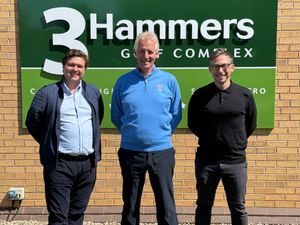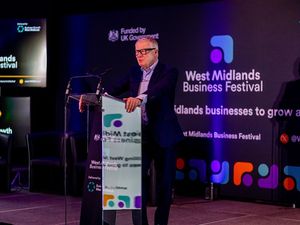Recovery plan to create 45,000 West Midlands jobs
The impact of the Covid-19 pandemic on the West Midlands economy was revealed as a fresh plan to re-ignite the regional economy was unveiled in Wolverhampton.
The West Midlands Combined Authority's Plan for Growth aims to bridge a £3.9 billion gap in the economy by 2030 and restore the region to its pre-pandemic position as the fastest growing English region outside London.
It would deliver 45,000 new high-value jobs.
West Midlands Mayor Andy Street told an audience at the Light House Cinema that the region had experienced a very tough time and suffered a 25 per cent drop in manufacturing in the two years of the pandemic– the worst in England. Exports had also fallen by the biggest percentage nationally in the area
The West Midlands economy shrank by 11 per cent in 2020 due, in part, to its large automotive sector and high number of exporting companies.
And, despite having the highest level of Foreign Direct Investment outside London and a strong track record in getting people back into work, the regional economy was still eight per cent smaller at the end of last year than at the onset of Covid.
The figures are in stark contrast to the decade up to 2019, when the West Midlands was the fastest growing region outside London, breaking through the £100 billion economic output mark.
Mr Street said: "No one in 2019 was expecting this situation to come."
He warned the region now faced further problems such as inflation and rising energy prices because of a high concentration of energy-intensive businesses, particularly in the Black Country.
The recovery needed to build on the region's key strengths including sectors that were performing better than the national picture including construction and logistics. There were also opportunities in low carbon manufacturing and green technology.
Mr Street said employment was at a record level and ahead of the national average but more needed to be done to improve skills working with colleges.
A recovery road map has been drawn up by leading private sector figures working with WMCA, local councils, universities and colleges. It focuses action on igniting eight economic clusters where the region already has a competitive advantage and in which businesses are confident to invest.
It shows how, with the right interventions, growing clusters such as electric vehicle manufacture, health and medical technology and construction, can be supercharged to help grow the West Midlands economy.
Mr Street said the private and public sectors had come together to set out a clear path for strong, clean and inclusive growth.
"Our focus is on driving investment to generate high value jobs and quality opportunities for local people that build on our traditional strong suits whilst looking to the growth sectors of the future.
“It must be a joint effort because while the public sector can use and is using its powers and funding to help lay the foundations for growth – think transport infrastructure, housing, urban regeneration and skills training – it will be the private sector that follows on with much greater investment and really drives delivery. Together, we will ensure we bounce back as a region.”
The plan proposes combining the power of the private and public sectors around eight clusters:
The manufacture of electric vehicles and battery storage devices
Modern and low carbon utilities such as solar and wind power technology
Logistics and distribution
The manufacture of the low carbon, factory-built homes of the future
Professional and financial services
Health and medical technology
Aerospace
Creative content production and video gaming
Councillor Ian Brookfield, WMCA portfolio holder for economy and innovation and leader of City of Wolverhampton Council, said: “Ongoing global supply chain frictions, a tight labour market, spiking energy costs and high inflation mean it’s never been more important for the West Midlands to support local people into high-quality jobs by capitalising on our strengths, in particular those economic clusters that can power a regional and national recovery.
“This Plan for Growth shows that by expanding those clusters, such as the development of low carbon modern methods of construction, and building a sustainable economy, we will be more diverse and resilient – and not so vulnerable to future shocks in one industry.
“With the private and public sectors working together to deliver this roadmap we can put the West Midlands economy back on an upward trajectory, eventually shrinking the gap between our region and London.”
The plan sets out a number of actions to support the eight clusters. On the manufacture of electric vehicles and battery storage it points to securing a new Gigafactory at Coventry, including energy networks and site support and an accelerated roll out of EV infrastructure, including charging.
It says the actions set out for this cluster alone have the potential to boost output by £850 million to £950m by 2030 and create a further 11,200 to 12,400 skilled jobs.
Margot James, executive chair of Warwick Manufacturing Group, which seeks to drive innovation in applied science, technology, and engineering and represents the cluster for manufacturing of electric vehicles, added: “The West Midlands is fortunate to have public and private sector leadership which understands the big issues facing our region and has come together to develop a clear, long-term plan that is focussed wholeheartedly on making the changes we need to transform our economy.
“I’m pleased that the Plan for Growth has such a strong focus on the innovation, skills, infrastructure and supply chains needed for these eight clusters including, of course, for the electrification of the automotive cluster, which is already seeing significant private sector investment for future growth.”
The audience heard how the WMCA and its partners were already laying the foundations for future success by investing more than £2bn in new transport, housing and skills schemes, using the UK Shared Prosperity Fund, CRSTS, Community Renewal Fund and other funding pots to drive growth and by securing new investment through an Innovation Accelerator.




